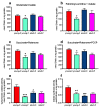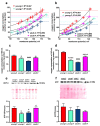Age-Dependent Skeletal Muscle Mitochondrial Response to Short-Term Increased Dietary Fructose
- PMID: 36829857
- PMCID: PMC9951991
- DOI: 10.3390/antiox12020299
Age-Dependent Skeletal Muscle Mitochondrial Response to Short-Term Increased Dietary Fructose
Abstract
The harmful effect of a long-term high-fructose diet is well established, but the age-dependent physiological responses that can be triggered by a short-term high-fructose diet in skeletal muscles have not been deeply explored. Therefore, the aim of this work was to compare the alterations in mitochondrial energetic and insulin responsiveness in the skeletal muscle induced by a short-term (2 weeks) fructose feeding in rats of different ages. For this purpose, fructose and uric acid levels, insulin sensitivity, mitochondrial bioenergetics and oxidative status were evaluated in the skeletal muscles from young (30 days old) and adult (90 days old) rats. We showed that, even in the short term, a high-fructose diet has a strong impact on skeletal muscle metabolism, with more marked effects in young rats than in adults ones. In fact, despite both groups showing a decrease in insulin sensitivity, the marked mitochondrial dysfunction was found only in the young rats, thus leading to an increase in the mitochondrial production of ROS, and therefore, in oxidative damage. These findings underscore the need to reduce fructose consumption, especially in young people, to preserve the maintenance of a metabolically healthy status.
Keywords: fructose; insulin resistance; mitochondria; oxidative stress; proton leak; skeletal muscle.
Conflict of interest statement
The authors declare no conflict of interest.
Figures






Similar articles
-
Skeletal muscle insulin resistance and adipose tissue hypertrophy persist beyond the reshaping of gut microbiota in young rats fed a fructose-rich diet.J Nutr Biochem. 2023 Mar;113:109247. doi: 10.1016/j.jnutbio.2022.109247. Epub 2022 Dec 7. J Nutr Biochem. 2023. PMID: 36496062
-
The effect of high-fat--high-fructose diet on skeletal muscle mitochondrial energetics in adult rats.Eur J Nutr. 2015 Mar;54(2):183-92. doi: 10.1007/s00394-014-0699-7. Epub 2014 Apr 18. Eur J Nutr. 2015. PMID: 24743896
-
Increased skeletal muscle mitochondrial efficiency in rats with fructose-induced alteration in glucose tolerance.Br J Nutr. 2013 Dec 14;110(11):1996-2003. doi: 10.1017/S0007114513001566. Epub 2013 May 22. Br J Nutr. 2013. PMID: 23693085
-
Dietary Sugars and Endogenous Formation of Advanced Glycation Endproducts: Emerging Mechanisms of Disease.Nutrients. 2017 Apr 14;9(4):385. doi: 10.3390/nu9040385. Nutrients. 2017. PMID: 28420091 Free PMC article. Review.
-
Cytosolic lipid excess-induced mitochondrial dysfunction is the cause or effect of high fat diet-induced skeletal muscle insulin resistance: a molecular insight.Mol Biol Rep. 2019 Feb;46(1):957-963. doi: 10.1007/s11033-018-4551-7. Epub 2018 Dec 8. Mol Biol Rep. 2019. PMID: 30535784 Review.
Cited by
-
Fructose-Induced Impairment of Liver and Skeletal Muscle Metabolism Is Prevented by Administration of Shouchella clausii Spores by Preserving Mitochondrial Function and Insulin Sensitivity.Mol Nutr Food Res. 2025 Jun;69(11):e70063. doi: 10.1002/mnfr.70063. Epub 2025 Apr 10. Mol Nutr Food Res. 2025. PMID: 40207597 Free PMC article.
References
Grants and funding
LinkOut - more resources
Full Text Sources

